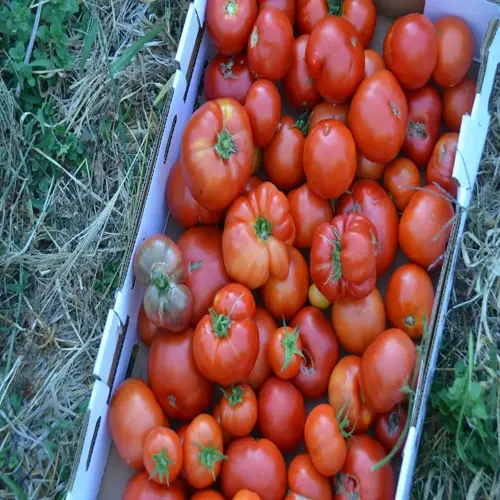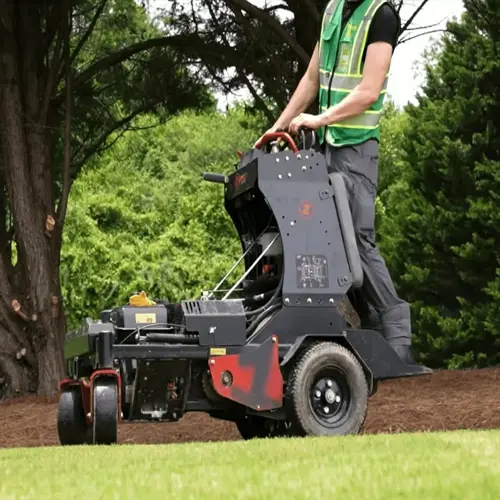10 Common Tomato Diseases and Prevention Tips

Written by
Kiana Okafor
Reviewed by
Prof. Martin Thorne, Ph.D.Recognize typical diseases of tomato as early as possible with leaf spots and fruit disorders.
Cultural practices to limit fungal diseases include using copper sprays and ensuring plants are spaced properly.
Bacterial diseases can be controlled by disinfecting tools and eliminating weeds in a timely manner.
Choose disease-resistant hybrid varieties to limit the need for chemical treatment.
Maintaining consistent soil moisture can prevent blossom end rot due to calcium deficiency.
Use a practice of crop rotation every season to disrupt the cycle of diseases within the soil.
Article Navigation
Each season, your garden is vulnerable to tomato diseases. They often are fungal, bacterial, and viral. They can be on leaves, stems, and fruit, sometimes resulting in spotting, mold, or rotting. Those infections can severely reduce yields, with many home gardens losing over half their tomatoes to disease.
Weather changes are often the impetus for outbreaks. Higher humidity allows for fungal spread. Temperature fluctuations can stress plants. Wet weather creates the ideal conditions. I lost an entire crop in humid July. Now I monitor forecasts and trends. Taking action earlier makes a major difference.
Keep a positive perspective on disease management. Most situations can be managed successfully if you start by selecting resistant varieties. You should monitor your plants every few days. You must act quickly at the first sign of trouble. You will be rewarded with the healthy tomatoes for your labor. Nothing feels better than a successful yield.
Preventing Tomato Diseases
The kind of soil you have directly correlates with disease risk, sandy soil drains quickly, which reduces the proliferation of fungus. Clay soil retains water longer, which can increase the likelihood of disease issues. I have compared the two in my garden. Sandy soil beds had far less trouble. You can also improve drainage in clay soils by adding organic matter.
Utilize drip irrigation to irrigate the plants. Watering on the foliage of plants facilitates the spread of fungal spores. Drip irrigation systems apply water to only the roots. By simply implementing this modification to your irrigation system, you will decrease fungal disease occurrence up to 70%. Utilize soaker hoses at the beginning of the season. Morning irrigation eliminates stagnant moisture from occurring overnight.
Rotating crops is like recharging the soil's immune system. Don't ever plant tomatoes in the same spot twice. Corn or beans should alternate with tomatoes for three years each. This helps break the disease cycle naturally! My rotation plan also keeps the soil healthy and productive.
Use copper sprays as a bacterial safeguard. Apply every 7-10 days when the skin is wet. Begin sprays before symptoms appear. This means treating both leaf surfaces. I make applications after rainfall because that is when the infections spread most rapidly. This barrier stops bacteria from establishing.
Soil Management
- Test pH levels every spring; tomatoes require 6.5-7.0 for optimal nutrient absorption
- Incorporate 3 inches (7.6 cm) of compost before planting to improve microbial health
- Apply agricultural lime if pH falls below 6.0 to prevent calcium deficiencies
- Solarize soil for 6 weeks during summer to eliminate pathogens naturally
- Add biochar at 5% soil volume to enhance water retention and microbial activity
- Conduct nematode tests using bait plants like marigolds to detect early infestations
Water Control
- Install drip systems to deliver water directly to roots avoiding leaf contact
- Water before 10 AM to allow foliage drying before evening humidity peaks
- Use moisture sensors to maintain consistent levels preventing drought stress
- Apply straw mulch at 4 inch (10 cm) depth to regulate soil temperature
- Measure soil percolation rates weekly; ideal is 1-2 inches (2.5-5 cm) per hour
- Adjust irrigation during heatwaves to prevent blossom end rot development
Sanitation Protocols
- Sterilize tools with 10% bleach solution between plants to prevent bacterial spread
- Remove plant debris immediately after harvest to disrupt disease life cycles
- Rotate crops annually using 3-year non-solanaceous plants like corn or beans
- Disinfect stakes annually with heat treatment at 120°C for 30 minutes
- Quarantine new plants for 14 days before introducing to garden beds
- Destroy infected plants by burning instead of composting to eliminate pathogens
Resistant Varieties
- Select 'Mountain Merit' for blight resistance with documented disease codes
- Choose 'Defiant' varieties showing tolerance to multiple fungal strains
- Prioritize certified disease-free seeds from reputable suppliers
- Combine resistant varieties with organic treatments for maximum protection
- Plant 'Nemadoro' tomatoes in nematode-prone sandy soil areas
- Use 'Verifi' cultivars where verticillium wilt is historically problematic
Companion Planting
- Interplant basil to repel thrips and whiteflies transmitting viral diseases
- Grow French marigolds to suppress root-knot nematodes in infected soils
- Position garlic near tomatoes to deter fungal spores through natural compounds
- Include borage to attract parasitic wasps that control hornworm populations
- Rotate with legumes like beans to fix nitrogen and improve soil structure
- Avoid planting potatoes nearby to prevent shared late blight contamination
10 Common Tomato Diseases
The majority of gardens experience early blight disease affecting 80% of tomato plants. Round spots with bullseyes will appear first on the lower leaves. Please take pictures of the symptoms to help identify them. Compare photos to online guides. Move swiftly, as spores spread quickly even in humidity.
Select resistant varieties before planting; they are your most effective defense against diseases. Mountain Merit tomatoes are highly resistant to blight. Defiant varieties resist several strains of fungus. I plant the resistant varieties first every season. They require less spraying/less work and reliably produce.
Copper sprays are more efficacious than neem oil applications. Copper prevents 75% of bacterial infections when applied earlier. Neem prevents only about 40% of outbreaks during a major epidemic. Use spray intervals of 7-10 days during periods of wet growth. Make sure to coat both *,abli, leaf surfaces.
Diagnosing issues based on symptoms is simple. Fungal spots have yellow halos. Bacterial infections have water-soaked lesions. Cut stems to check the vascular tissue. Wilting plants should be evaluated for roots. If uncertain, take samples to extension services for confirmation.
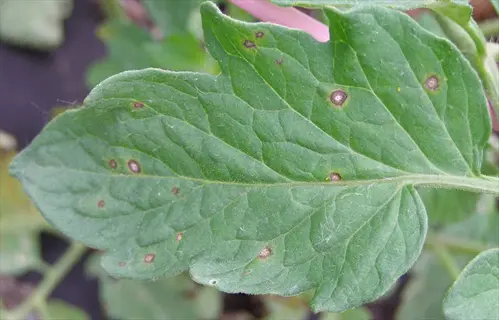
Early Blight
- Fact: Bullseye-patterned lesions appear on lower leaves first during humid weather
- Remove infected leaves immediately to reduce spore spread by 60%
- Apply copper fungicide every 7-10 days during rainy periods
- Space plants 24-36 inches (61-91 cm) apart for airflow
- Solarize soil at 120°F (49°C) for 6 weeks to kill pathogens
- Harvest fruit early if lesions spread to stems
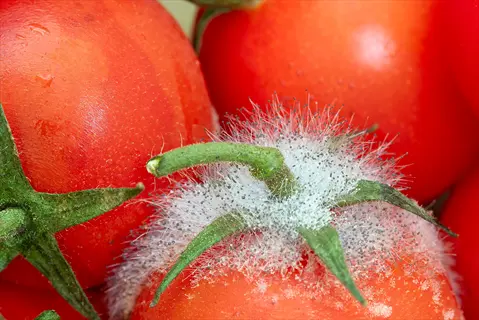
Late Blight
- Fact: Olive-green lesions expand rapidly in cool, wet conditions below 80°F (27°C)
- Destroy infected plants, do not compost, to prevent soil contamination
- Use potassium bicarbonate spray at first sign of infection
- Cover plants with row covers during prolonged rain events
- Plant resistant varieties like 'Mountain Magic' in high-risk zones
- Avoid overhead watering to limit spore dispersal
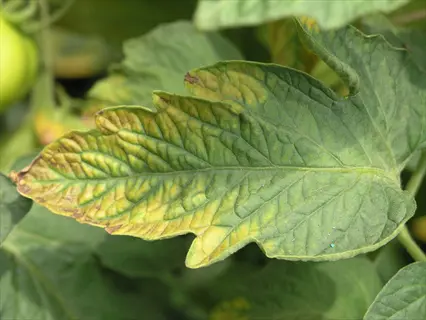
Fusarium Wilt
- Fact: Yellowing starts on lower leaves with vascular tissue turning brown
- Solarize soil for 6 weeks when temperatures exceed 95°F (35°C)
- Select F1 hybrid seeds labeled 'F' resistant for infected areas
- Maintain soil pH 6.5-7.0 to inhibit fungal growth
- Apply Bacillus subtilis biofungicide to root zones monthly
- Rotate with corn or beans for 3 years between tomato plantings
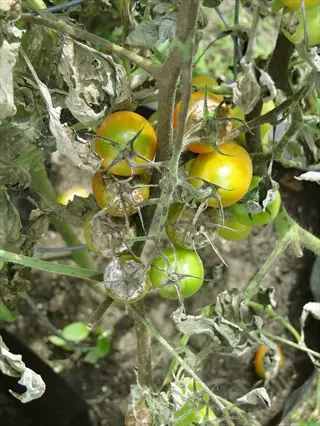
Bacterial Spot
- Fact: Water-soaked spots darken into scabby lesions within 48 hours
- Spray streptomycin sulfate after wind-driven rain events
- Remove weeds within 10 feet (3 m) of garden beds
- Water before 10 AM to ensure leaf drying by midday
- Disinfect stakes with 10% bleach solution annually
- Use UV-treated seeds to eliminate bacterial carriers
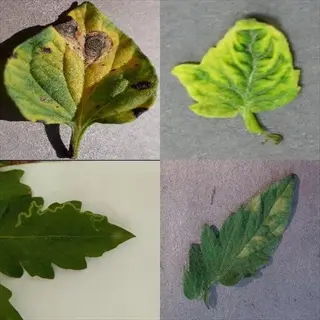
Tomato Mosaic Virus
- Fact: Fern-like distortion reduces photosynthesis by 50% in severe cases
- Wash hands with soap before touching plants to prevent mechanical transmission
- Quarantine new seedlings for 14 days before transplanting
- Control aphids using insecticidal soap sprays twice weekly
- Destroy infected plants, virus survives 50 years in dried plant debris
- Plant TMV-resistant varieties like 'Big Beef' in contaminated soils
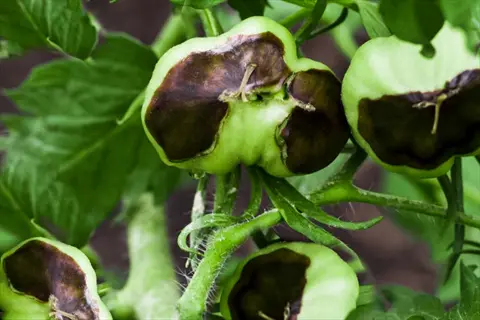
Blossom End Rot
- Fact: Calcium deficiency causes leathery black patches on fruit undersides
- Maintain consistent soil moisture using drip irrigation systems
- Add gypsum at 1 lb per 10 sq ft (0.5 kg per 1 m²) if calcium deficient
- Avoid high-ammonium fertilizers during fruit development stages
- Apply calcium nitrate foliar spray during early fruiting phase
- Mulch with 4 inches (10 cm) of straw to regulate water
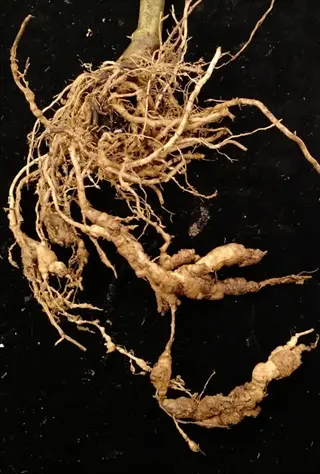
Root Knot Nematodes
- Fact: Nematodes cause 30-70% yield loss in sandy soils above 80°F (27°C)
- Solarize soil for 6 weeks when temperatures exceed 100°F (38°C)
- Plant marigolds as cover crop 3 months before tomatoes
- Apply chitin amendments at 5 oz per sq yd (170g per m²)
- Introduce beneficial Steinernema nematodes in early spring
- Choose 'Nemadoro' varieties with documented nematode resistance
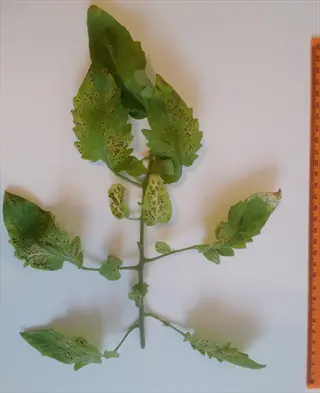
Anthracnose
- Fact: Fungus spreads fastest on overripe fruit during warm, wet weather
- Harvest tomatoes at first blush (pink stage) to avoid infection
- Apply sulfur dust every 7 days during high-humidity periods
- Trellis plants to elevate fruit 12 inches (30 cm) above soil
- Remove fallen fruit within 24 hours to disrupt spore cycles
- Rotate away from nightshades for 4 years after outbreaks
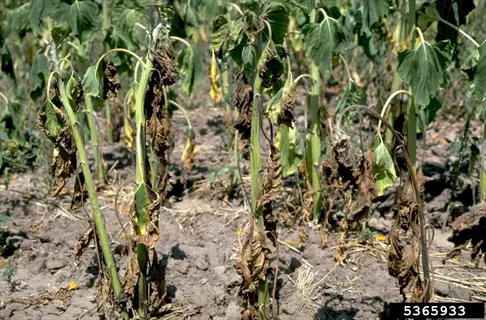
Verticillium Wilt
- Fact: V-shaped yellowing progresses upward despite adequate watering
- Build raised beds 12 inches (30 cm) high for improved drainage
- Select 'Verifi' or 'Defiant' varieties with V-resistance coding
- Apply compost tea weekly to boost beneficial microbes
- Avoid planting in soils colder than 60°F (16°C) in spring
- Rotate with corn for 3 consecutive years
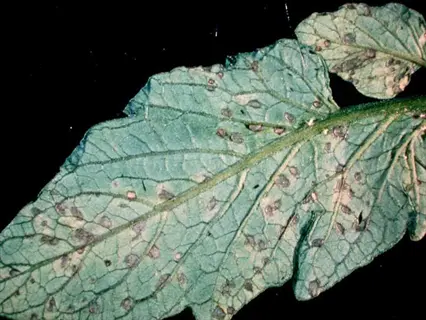
Septoria Leaf Spot
- Fact: Gray spots with yellow halos spread upward from soil splash
- Sterilize pruners with 70% alcohol between plants
- Remove leaves within 12 inches (30 cm) of soil surface
- Spray neem oil solution every 10 days during humid months
- Use certified disease-free seeds for new plantings
- Mulch with 3 inches (7.6 cm) of grass clippings to block spores
Diagnosing Disease Symptoms
Inspect leaf patterns shortly after rainfall. Fungal spots develop quickly if high humidity persists. Bacterial spots appear slowly over days. I learned this one rainy summer when my plants exhibited symptoms 2 days after the storm. Having access to community weather information allows you to anticipate potential outbreaks.
Differentiate bacterial from fungal spots by touch. Fungal lesions feel dry like parchment. Bacterial spots remain water-soaked and smooth. Note the yellow halos around spots from bacterial infections. Fungal spots can spread without borders. Use a loupe to validate these differences.
If your plants wilt rapidly, snip into the soil and check the roots. Dig and inspect the substrate surrounding the plant's base. White, firm roots are good. Brown, mushy roots are bad. Last season, I found nematode knots like this. Early intervention saved the adjacent plants.
Use a 10x magnifier to inspect leaves casually. The tiny spider mites create stippling damage. Check for webbing on the underside. Thrips will leave silver streaks on leaves. I keep a pocket magnifier in my garden apron, and that's how I find pests before they become a problem.
Leaf Discoloration
- Pattern: Yellowing starting from edges indicates potassium deficiency
- Pattern: Circular brown spots with halos suggest bacterial infection
- Inspect leaf undersides for powdery mildew or insect eggs
- Test soil pH if yellowing is uniform; ideal is 6.5-7.0 for tomatoes
- Compare symptoms during dry vs. wet spells to isolate environmental causes
- Document progression with daily photos to track spread speed
Fruit Abnormalities
- Pattern: Sunken black spots on blossom end signal calcium deficiency
- Pattern: Radial cracks indicate rapid growth after drought
- Check fruit firmness: soft spots suggest fungal rot
- Measure lesion expansion; >0.5 inch (1.3 cm)/day implies blight
- Cut open fruit to inspect internal discoloration or mold
- Record temperatures during development; heat above 90°F (32°C) causes deformities
Stem and Root Issues
- Pattern: Brown vascular tissue when stems are cut confirms wilt disease
- Pattern: Swollen roots with knots indicate nematode damage
- Dig 6 inches (15 cm) deep to check root color and texture
- Conduct soil nematode test using marigold bait plants
- Assess stem strength: brittle stems suggest viral infection
- Check for oozing sap which may indicate bacterial canker
Wilting and Stunting
- Pattern: Sudden midday wilting points to bacterial wilt
- Pattern: Gradual stunting with leaf curl indicates viruses
- Test soil moisture: overwatering mimics root rot symptoms
- Examine roots for rot or discoloration to rule out phytophthora
- Look for borer insects inside stems using flashlight
- Isolate plant immediately if contagious pathogens are suspected
Environmental Mimics
- Pattern: Leaf curling during heatwaves is physiological stress
- Pattern: Blossom drop below 55°F (13°C) is temperature shock
- Measure soil temperature: cold soils <60°F (16°C) cause purple leaves
- Review wind exposure: physical damage resembles pest feeding
- Check fertilizer logs: salt buildup burns leaf tips
- Adjust care before diagnosing, 50% of symptoms resolve with environmental fixes
Treatment Strategies
Select a treatment according to the stage of infection. Copper fungicides are effective 85% of the time during early outbreaks. Neem oil has only 50% efficacy with severe infestations. I start with copper as soon as I see the first signs of spots. When I see a cluster of spots, I switch to more powerful treatment options. If the spots continue to increase quickly, it is time to make the switch. The effects of timing are more important than the products you choose.
Always practice safe handling of chemical treatments. Use gloves and masks with each application. Read and follow the guidelines for use established by the EPA and on the product label. Store below in a locked cabinet designed for chemicals, out of the reach of children. I triple-rinse sprayers after each use. Do not apply anytime near harvest. Always protect yourself and the environment.
Mixing and matching is the way to go! You can utilize nematodes as part of a crop rotation strategy. Use compost tea and maintain proper plant spacing to ensure optimal growth. This combo brought my garden back last season! Biological control increases plant defenses. Cultural practices decrease disease pressure naturally. Integration always beats a single approach.
Treat early infections aggressively. Remove infected leaves immediately. Spray copper every five days initially. Advanced cases need systemic fungicides. Rotate products to prevent resistance. I keep a treatment journal. Record dates and responses. Adjust strategies based on plant recovery.
Organic Sprays
- Priority: Apply copper fungicide at first symptom - mix 2 oz/gal (60ml/4L) water
- Spray neem oil every 7 days during humid periods for fungal suppression
- Use baking soda solution (1 tbsp/quart or 15ml/L) for mild mildew cases
- Rotate treatments to prevent pathogen resistance development
- Apply early morning to avoid leaf burn and maximize absorption
- Test spray on single leaf before full application to check phytotoxicity
Soil Amendments
- Priority: Incorporate compost tea biweekly - brew 24 hours before use
- Add gypsum at 1 lb/10 sq ft (0.5kg/m²) for calcium-deficient soils
- Mix biochar at 5% soil volume to boost microbial antagonism
- Apply mycorrhizal fungi inoculants during transplanting
- Solarize soil 6 weeks pre-planting at 120°F (49°C) minimum
- Balance pH to 6.5-7.0 using agricultural lime if below 6.0
Biological Controls
- Priority: Release Steinernema nematodes for root-knot nematodes - 1 million/sq yd (1.2M/m²)
- Introduce Trichoderma fungi to outcompete Fusarium pathogens
- Attract ladybugs with companion plants for aphid control
- Apply Bacillus subtilis as root drench for wilt prevention
- Use Beauveria bassiana for whitefly infestations in greenhouses
- Establish habitat for parasitic wasps to control hornworms
Chemical Interventions
- Priority: Use chlorothalonil for blight - apply 1.5 oz/gal (45ml/4L) with PPE
- Rotate mancozeb and azoxystrobin to delay resistance
- Limit streptomycin to bacterial outbreaks only
- Follow 14-day pre-harvest interval for systemic fungicides
- Store chemicals in locked cabinets below 80°F (27°C)
- Dispose of empty containers through hazardous waste programs
Cultural Practices
- Priority: Remove infected plants immediately - burn or bag, never compost
- Sterilize tools with 10% bleach after each plant contact
- Rotate crops annually - 3-year minimum for nightshades
- Prune lower leaves 12 inches (30 cm) above soil to improve airflow
- Water via drip irrigation only - avoid overhead sprinklers
- Select disease-resistant varieties like 'Mountain Merit' for blight zones
5 Common Myths
Blossom end rot in tomato plants can be fixed with Epsom salt because it supplies the plant with calcium.
Epsom salt consists of magnesium sulfate, not calcium, and will not correct any calcium deficiencies that are responsible for blossom end rot. Blossom end rot is caused by uneven watering of the plant or root damage that limits calcium transport to the fruit. To fix the issue, simply keep the soil evenly moist by using drip irrigation, and adding gypsum only if a soil test indicates a calcium deficiency. It is also important to do regular soil testing each spring to avoid unnecessary amendments to the soil for the complete growing season.
Heirloom tomato varieties are genetically disease-resistant than modern hybrids are.
Hybrids are bred for disease resistance through crossings with more than one parent line, creating/taking advantage of multiple genetic strains that ultimately provide signs of stronger genetic resistance to the pathogens that cause diseases like fusarium wilt and verticillium. Heirloom tomatoes are flavorful, but they don't have those same diseases resistances targeted by modern hybrid breeding programs, meaning that you'll have to manage heirloom tomatoes more intensely in gardens where disease is a problem. Further, modern breeding programs produce/take advantage of genetic resistance markers that heirlooms simply do not possess.
Tomato diseases always show immediate visible symptoms after infection occurs.
Many diseases have incubation periods; bacterial spot takes 7-10 days to develop visible lesions, and verticillium wilt may remain latent until plants experience stress. Regular monitoring for subtle changes like slight leaf curling is essential for early intervention. Asymptomatic carriers can spread infections before showing signs themselves.
Organic gardening means never using any chemical treatments for diseases.
Organic standards allow EPA-approved chemicals like copper fungicides and sulfur sprays when used minimally during severe outbreaks. These must be combined with cultural practices like crop rotation for sustainable control. The National Organic Program permits specific synthetics when natural methods are insufficient.
Compost tea can prevent all fungal and bacterial diseases in tomatoes.
Compost tea boosts beneficial microbes that suppress some pathogens but is ineffective against viral diseases like tomato mosaic virus or soil-borne nematodes. It should complement other strategies like solarization and resistant varieties rather than replace them. Apply as a soil drench every two weeks during high-risk periods for partial protection.
Conclusion
Follow your basic prevention plan. Incorporate sanitation, resistant varieties, and consistent monitoring, and clean tools between each use. Promptly destroy diseased plants. Use a proven variety such as Mountain Merit. Monitor plants every few days. This trio is the best defense system for your garden!
Act promptly as soon as you notice a problem arises. Timely treatment reduces crop loss by 60-80%! I save my crop by treating it with a spray when I first see spots. If I had waited even 3 days, I would have doubled the damage. Have your treatments for bad weather conditions at the ready. Action pays off every time with sound, healthy tomatoes.
Envision a season of harvests that are free from disease. Your efforts guarantee this success. When plants are free of disease, they yield enough to eat. You avoid pain and waste. You'll be eating fresh tomatoes each day. You can give away your excess to neighbors. This situation makes every prevention effort 100% worthwhile.
Select one strategy now. Install drip irrigation before the next rain - or plant resistant varieties this weekend. Small steps make for big protection. My first action was crop rotation. Now you choose your first step. Your tomatoes will thank you later.
External Sources
Frequently Asked Questions
What are the most common tomato diseases?
The most frequent tomato diseases include early blight, late blight, fusarium wilt, blossom end rot, and bacterial spot. These typically show symptoms like leaf spots, fruit rot, or plant wilting. Prevention focuses on proper spacing, resistant varieties, and soil management.
How can I identify problems with my tomato plants?
Examine these key symptom categories:
- Leaf discoloration: Yellow edges may indicate potassium deficiency
- Fruit abnormalities: Sunken black spots suggest blossom end rot
- Stem issues: Brown vascular tissue when cut signals wilt disease
- Environmental stress: Curling leaves during heatwaves
Should I remove diseased tomato leaves?
Yes, promptly remove infected leaves using sterilized tools to prevent disease spread. Destroy them by burning or bagging - never compost. This reduces spore transmission by up to 60%. Always disinfect tools with bleach solution after contact with diseased plants.
What does Epsom salt do for tomatoes?
Epsom salt provides magnesium but doesn't prevent blossom end rot. While it can address magnesium deficiency symptoms, it won't solve calcium-related issues. Use gypsum for calcium problems instead, and always test soil before applying any amendments.
How often should I water tomato plants?
Water tomatoes deeply using drip irrigation before 10 AM, allowing soil to dry slightly between waterings. Frequency depends on temperature and soil type, but maintain consistent moisture to prevent cracking and blossom end rot.
Are coffee grounds beneficial for tomatoes?
Coffee grounds can moderately help tomatoes by:
- Adding organic matter to improve soil structure
- Providing slow-release nitrogen during decomposition
- Slightly acidifying soil which benefits tomatoes
- Use sparingly to avoid nitrogen imbalance
Why do tomato plant leaves turn yellow?
Yellow leaves result from multiple causes:
- Nutrient deficiencies: Nitrogen or potassium shortages
- Diseases: Fusarium wilt or viral infections
- Water issues: Overwatering or poor drainage
- Environmental stress: Temperature extremes or sunscald
How do I treat tomato plant diseases organically?
Effective organic treatments include:
- Copper fungicide sprays for fungal issues
- Neem oil applications every 7 days
- Baking soda solution for mild mildew
- Beneficial nematodes for soil-borne pests
- Compost tea to boost beneficial microbes
Can tomato plants get too much sun?
While tomatoes need 6-8 hours of sun, excessive heat above 90°F causes sunscald, blossom drop, and leaf curl. Provide afternoon shade in hot climates using shade cloth, and ensure adequate watering during heatwaves.
What kills tomato plants quickly?
Sudden tomato plant death typically results from:
- Bacterial wilt which causes rapid collapse
- Severe root rot from overwatering
- Herbicide contamination or chemical burns
- Extreme temperature fluctuations
- Advanced fungal infections like late blight
